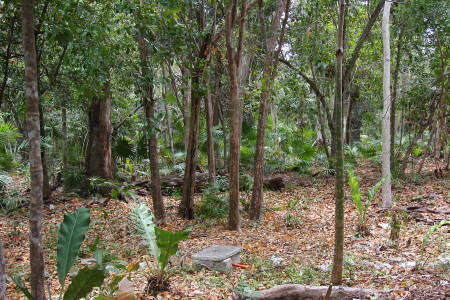
This 150 acre botanical garden also know as Ya’ax Che is the last patch of conserved forest between Cancun and Playa del Carmen. Established in 1982, the main objectives of the park are to preserve and propagate endangered plant species as well as inform and educate visitors about how the mayans used the natural resources of this area. To this end, there is an interpretive trail of about 4 km with a variety of exhibits set in a natural forest environment representative of the complete eco-system existing in the Yucatan Peninsula. The distinct exhibits consist of cactus, orchids, ferns, ornamentals, palms and medicinal plants, Additionally, there are maya ruins, a recreated traditional mayan home and “chicle camp” where sap from chicle trees was used to make the chewing gum which bears its name. Wild fauna such as spider monkeys, lizards and a variety of birds can also be seen along the trails. For more information and images about this park, see the photo essay below.

A guide to the exhibits found on the 4km interpretive trail

This is a Tradescania Pallida plant native to the Yucatan used for ornamental purposes

There are 20 different kinds of palmae in the yucatan peninsula and 15 of them are part of this parks collecton that includes this Corozo palm

The palmae exhibit includes this Kuka which is native to the yucatan and now considered an endangered species

dedicated to Dr. Ingrid Olmsted who was a pioneer in promoting biodiversity around the yucatan peninsula

The palms on the right are the sabel mexicana native to the yucatan and used in the construction of palpa thatched roofs

This solar home is part of a Ethnographic Exhibition which also includes an apiary, vegetable garden and medicinal plants that were used to supplement the family economy.

part of the maya ethnography exhibit, this Liliaceae plant was used as a traditional medicine for resporatory ailments

a variety of ferns and a reading center are found in this exhibit

a fern native to the yucatan and florida considered to be a threatened species

Maya ruins in the park called the Altar

recreation of a chiclero camp production facility where sap from the chicle tree was boiled down and cast into blocks that formed a base for chewing gum later called chiclets

on the way to the swing bridge, this trail is an representative of a medium height deciduous forest

This bridge crosses a valley which floods in the raining season and leads to an observation tower with a birds eye view

the ever present Iguana turns up almost everywhere in the maya riviera
















